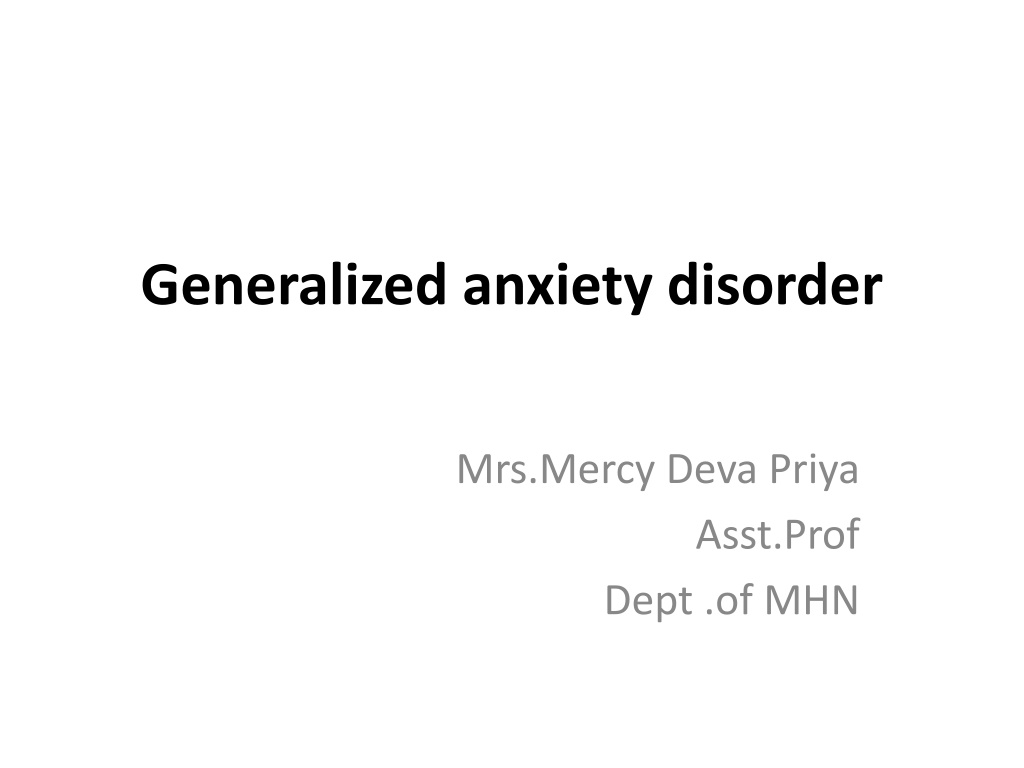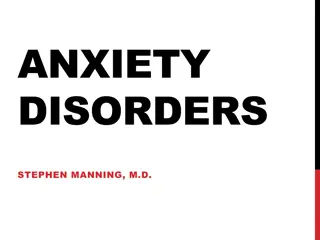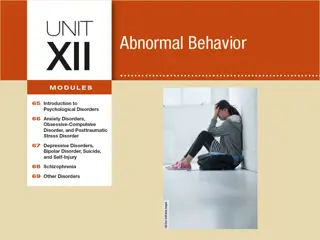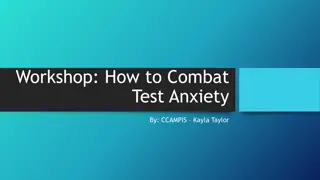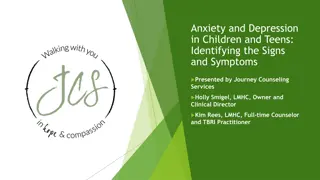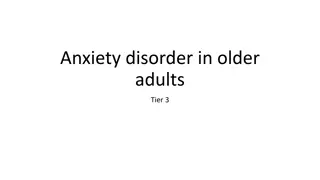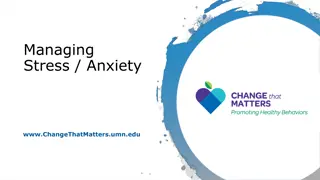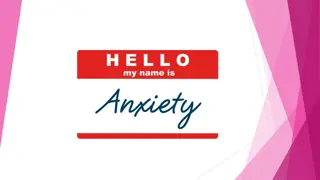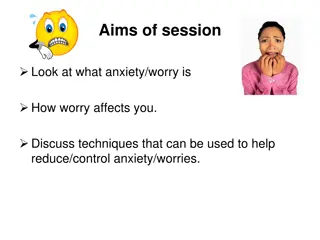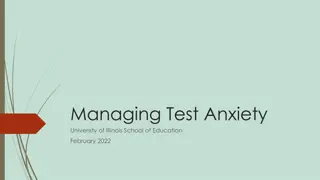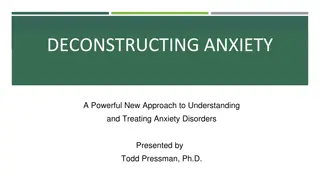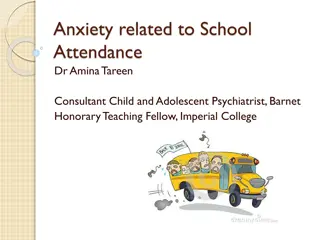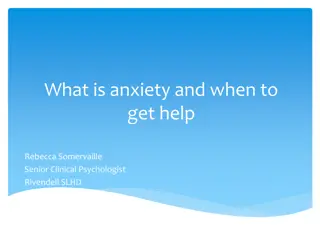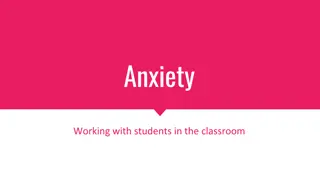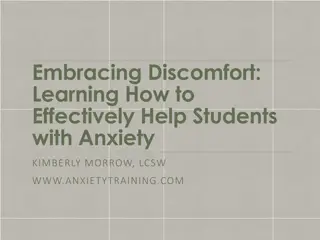Generalized Anxiety Disorder
Generalized Anxiety Disorder (GAD) is a type of anxiety disorder characterized by excessive, uncontrollable worry. Symptoms include restlessness, concentration difficulties, muscle tension, and sleep disturbance. Treatment options include cognitive behavioral therapy and SSRIs.
Download Presentation

Please find below an Image/Link to download the presentation.
The content on the website is provided AS IS for your information and personal use only. It may not be sold, licensed, or shared on other websites without obtaining consent from the author.If you encounter any issues during the download, it is possible that the publisher has removed the file from their server.
You are allowed to download the files provided on this website for personal or commercial use, subject to the condition that they are used lawfully. All files are the property of their respective owners.
The content on the website is provided AS IS for your information and personal use only. It may not be sold, licensed, or shared on other websites without obtaining consent from the author.
E N D
Presentation Transcript
Generalized anxiety disorder Mrs.Mercy Deva Priya Asst.Prof Dept .of MHN
Generalized anxiety disorder Generalized anxiety disorder (GAD) is an anxiety disorder that is characterized by excessive, uncontrollable and often irrational worry about everyday things that is disproportionate to the actual source of worry.
Symptoms of GAD (present most days for at least 6mths) DSM-IV At least 3 (or 1 in children) out of: restlessness or feeling keyed up or on edge; easy fatiguability; concentration difficulties or mind going blank irritability; muscle tension; sleep disturbance. ICD-10 At least 4 (with at least 1 from autonomic arousal out of: Symptoms of autonomic arousal: palpitations/tachycardia; sweating; trembling/shaking; dry mouth. Physical symptoms: breathing difficulties; choking sensation; chest pain/discomfort; nausea/abdominal distress. Mental state symptoms: feeling dizzy, unsteady, faint or lightheaded; derealisation/depersonalisation; fear of losing control, going crazy, passing out, dying.
General symptoms: hot flushes/cold chills; numbness or tingling sensations. Symptoms of tension: muscle tension/aches and pains; restlessness/ inability to relax; feeling keyed up, on edge, or mentally tense; a sensation of a lump in the throat or difficulty swallowing. Other: exaggerated responses to minor surprises/being startled; concentration difficultiesmind going blank due to worry or anxiety; persistent irritability; difficulty getting to sleep due to worrying. Course Chronic and disabling, prognosis generally poor, remission rates low (-30% after 3yrs, with treatment), 6yr outcome 68% mild residual symptoms, 9% severe persistent impairment. Often comorbidity becomes more significant (esp. alcohol misuse) and this worsens the prognosis
Treatment A meta-analysis of 35 studies shows cognitive behavioral therapy to be more effective in the long term than pharmacologic treatment (drugs such as SSRIs), and while both treatments reduce anxiety, CBT is more effective in reducing depression.
Cognitive behavioral therapy SSRIs ( Selective serotonin reuptake inhibitor) paroxetine (Paxil, Aropax) escitalopram (Lexapro, Cipralex) sertraline (Zoloft)
Other Drugs Buspirone (BuSpar). Buspirone (BuSpar) is a serotonin receptor agonist belonging to the azaspirodecanedione class of compounds. Duloxetine (Cymbalta) Imipramine (Tofranil). Imipramine (Tofranil) is a tricyclic antidepressant (TCA). TCAs are thought to act on serotonin, norepinephrine, and dopamine in the brain. Venlafaxine (Effexor, Effexor XR). Venlafaxine (Effexor) is a serotonin-norepinephrine reuptake inhibitor (SNRI). SNRIs, a class of drugs related to the SSRIs, alter the chemistries of both norepinephrine and serotonin in the brain. Propranolol (Inderal)
Benzodiazepines alprazolam (Xanax, Xanax XR, Niravam) chlordiazepoxide (Librium) clonazepam (Klonopin) clorazepate (Tranxene) diazepam (Valium) lorazepam (Ativan)
NURSING MANGMENT OF GAD CLIENT ASSESSMENT DATA BASE Activity/Rest Restlessness, pacing anxiously, or, if seated, restlessly moving extremities Feeling keyed up / on edge, unable to relax Easily fatigued Difficulty falling or staying asleep; restlessness, unsatisfying sleep Circulation Heart pounding or racing/palpitations; cold and clammy hands; hot or cold spells, sweating; flushing, pallor High resting pulse, increased blood pressure
Ego Integrity Excessive worry about a number of events/activities, occurring more days than not for at least 6 months Complains vociferously about inner turmoil, has difficulty controlling worry May demand help Facial expression in keeping with level of anxiety felt (e.g., furrowed brow, strained face, eyelid twitch) May report history of threat to either physical integrity (illness, inadequate food and housing, etc.) or self- concept (loss of significant other; assumption of new role)
Elimination Frequent urination; diarrhea Food/Fluid Lack of interest in food, dysfunctional eating pattern (e.g., responding to internal cues other than hunger) Dry mouth, upset stomach, discomfort in the pit of the stomach, lump in the throat
Neurosensory Absence of other mental disorder, such as depressive disorder or schizophrenia Motor tension: shakiness, jitteriness, jumpiness, trembling, muscle tension, easily startled Dizziness, lightheadedness, tingling hands or feet Apprehensive expectation: anxiety, worry, fear, rumination, anticipation of misfortune to self or others, inability to act differently (feeling stuck) Excessive vigilance/hyperattentiveness resulting in distractibility, difficulty in concentrating or mind going blank, irritability, impatience Free-floating anxiety usually chronic or persisting over weeks/months Pain/Discomfort;Muscle aches, headaches
Respiratory Increased respiratory rate, shortness of breath, smothering sensation Sexuality Women twice as likely to be affected as men Social Interactions Significant impairment in social/occupational functioning Teaching/Learning Age of onset usually 20s and 30s
DIAGNOSTIC STUDIES Drug Screen: Rules out drugs as contribution to cause of symptoms. Other diagnostic studies may be conducted to rule out physical disease as basis for individual symptoms (e.g., ECG for severe chest pain, echocardiogram for mitral valve prolapse; EEG to identify seizure activity; thyroid studies).
NURSING PRIORITIES 1. Assist client to recognize own anxiety. 2. Promote insight into anxiety and related factors. 3. Provide opportunity for learning new, adaptive coping responses. 4. Involve client and family in educational/support activities.
DISCHARGE GOALS 1. Feelings of anxiety recognized and handled appropriately. 2. Coping skills developed to manage anxiety- provoking situations. 3. Resources identified and used effectively. 4. Client/family participating in ongoing therapy program. 5. Plan in place to meet needs after discharge
